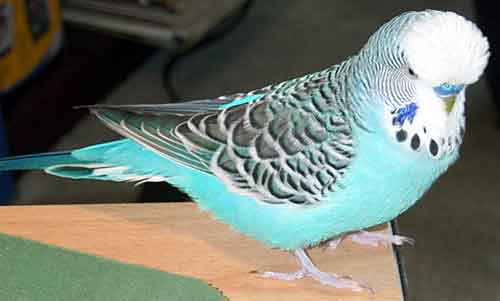|

History of the Budgerigar
First recorded in the wild in the late 1700s by a colonist near Parramatta, the budgerigar (Melopisittacus undulatus) has become the most popular cage bird in the world. The name budgerigar comes from the Australian Aboriginal word betcherrygah, which means good food.
The budgie is a native species to the Australian mainland. Large flocks, sometimes in the tens of thousands, inhabit the open grasslands in central Australia, nesting in the spring and summer in the southern areas of the continent. Pairs will nest wherever there is sufficient food for the flock, making their nests in tree hollows, rotting wood, under rocks and even by digging holes in the ground. Nesting usually takes place after rainfall, due to the availability of food and water.
The native budgerigar is a light green colour, with a yellow head and undulating black bands down the back of the head and wings. It is from these wild birds that the first domestic budgerigars were bred, and the species has evolved into the many varieties present today. The first captive breeding took place in Europe in the mid 1850s, leading to various colour and feather structure mutations.
--------------------------------------------------------------------------------
History of Varieties
Yellow was the first recorded variation on the wild green budgerigar, occurring in around 1870 in Germany or Belgium.
Sky Blue was first recorded in 1878, but this early mutation was lost through lack of breeding knowledge about the bird. The Dutch successfully bred sky blues at a later stage, and this variation on the normal green bird proved very popular.
Laurel (Dark Blue) was first recorded in commercial aviaries by the French in 1915. Olive followed in 1916, by breeding the Laurel birds together.
Cobalt and Mauve followed as the Laurel and Olive birds were mixed with Sky Blue.
Whites were recorded in England and France in 1920, by breeding blues with yellows.
Greywings appeared in Germany and Belgium as early as 1875 in the green birds, and followed in blue in 1928.
Clearwing was first recorded in Australia in the 1930s, by the late Mr H. Pier of Sydney.
Fallow occured in Australia, Europe and England in the early 1930s. The Australian variety first appeared in the aviaries of a Mr O'Brien of Sydney.
Danish Pied , (also called Harlequins or Recessive Pieds) first appeared in 1932.
Saddlebacks were first recorded in the aviaries of L and B Ryan of Sydney.
Australian Dominant Grey first appeared around 1934. This was followed by the British Recessive Grey, which proved less popular and has virtually died out.
Violet occured some time in the mid 1930s, and is claimed by Australia, Denmark and Scotland. The variety caused initial confusion, as a dark green violet can appear olive.
Yellow Faced Blue occurred in the mid 1930s in England, and caused almost as much interest as the original sky blue mutation.
Australian Dominant Pieds and Dutch Dominant Pieds appeared around 1932. The Australian variety occurred in Sydney, and has proved more popular than the Dutch variety.
Continental Clearflights appeared in Belgium in 1946.
Cinnamons appeared in Australia, Germany and England between 1931 and 1934.
Lutinos and Albinos occured in the 1930s. They are known collectively as 'Inos', the Lutino being the green series and the Albino the blue.
Opaline was established in Scotland and Australia in the early 1930s. Like Cinnamons and Inos, Opalines are a sex-linked variety, caused by a mutation of the X and Y chromosomes.
Lacewing is also a sex-linked variety and first occurred in Queensland, Australia.
Spangle is the most recent mutation, occurring in the aviaries of Melbourne breeder Merv Jones in 1974.
Crested budgerigars are a feather mutation that alter the feathers on the head of the bird. They have not really proved to be popular in breeding circles

|